
Toshiba EMI Odeon and Apple Label
03. A Hard Day's Night (OP-7123, OP/AP-8147)
(Update: 27th. May 2024)

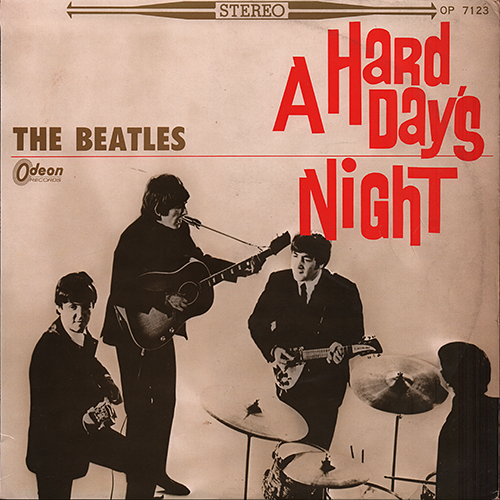 Odeon 1st. Sleeve |
|
|
| TITLE | A HARD DAY'S NIGHT | ||||
| CATALOG NUMBER | OP-7123 |
||||
| RELEASE DATE | Test Press (First Press: 5th
September.1964) |
||||
| TRACK LISTING | SIDE 1 | SIDE 2 | |||
| A Hard Day's Night |
Any Time At All |
||||
| I Should Have Known Better |
I'll Cry Instead |
||||
| If I Fell |
Things We Said Today |
||||
| I'm Happy Just To Dance With You |
When I Get Home |
||||
| And I Love Her |
You Can't Do That |
||||
| Tell Me Why |
I'll Be Back | ||||
| Can't Buy Me Love | |||||
| FRONT --> Click! | BACK --> Click! | SIDE 1 --> Click! | SIDE 2 --> Click! | DISK | |
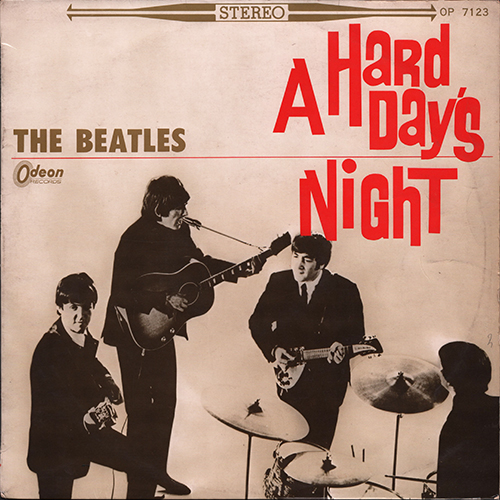 |
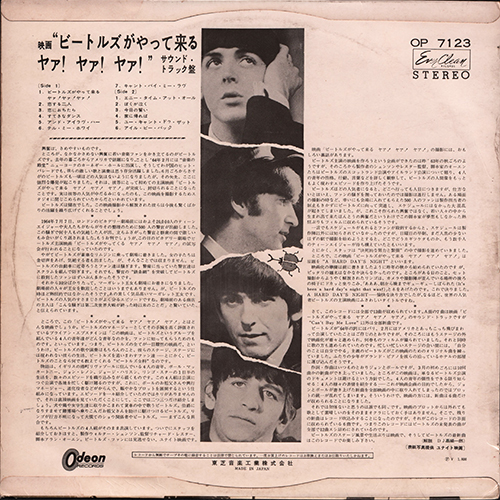 |
 |
 |
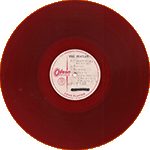 |
|
| INNER SLEEVE |
LYRIC
SHEET (Slip Sheet Type)
|
The
original
plain white inner bag has a fold-over flap at the top of the
bag to prevent the record from falling out. The lyric sheet is slip sheet type. |
|||
| FRONT --> Click! | BACK --> Click! | FRONT --> Click! | BACK --> Click! | ||
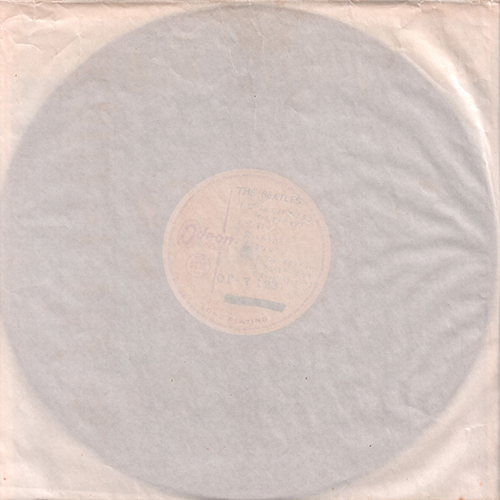 |
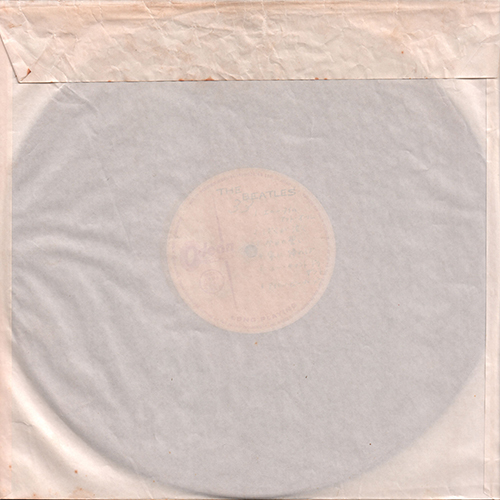 |
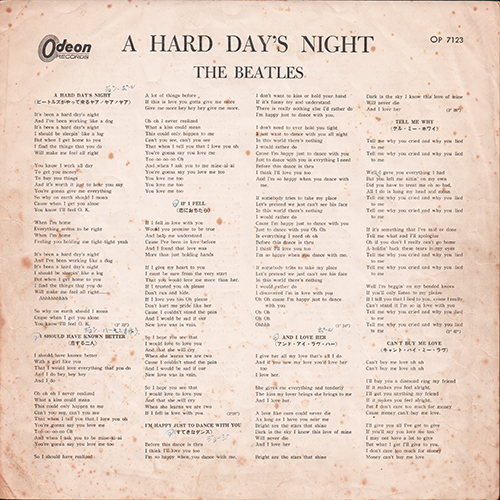 |
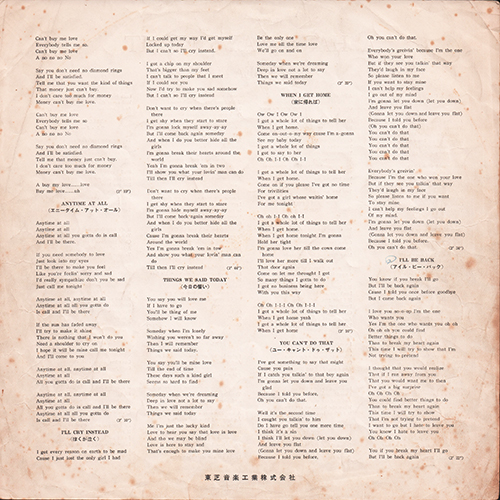 |
||
| LYRIC SHEET CLOSE
UP |
|||||
 |
 |
Catalog number and the company name "Toshiba Musical Industries Ltd." were printed on the lyric sheet. | |||
| FRONT COVER CLOSE UP | |||||
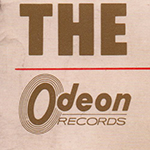 |
 |
 |
|||
| Odeon
logo mark and catalog number "OP 7123" were printed on the
front sleeve. Issues with a "STEREO" banner across the top of the cover. |
|||||
| BACK COVER CLOSE UP | |||||
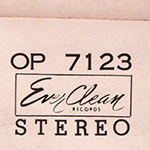 |
Toshiba pressed a lot of their records on red, “Everclean” vinyl. The Everclean vinyl was designed to be less prone to collecting static electricity and dust than the more common black vinyl. | 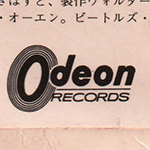 |
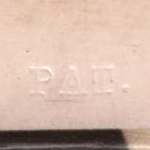 |
Odeon logo mark was
printed at the lower left corner of the back cover. The words "PAT." was embossed at the bottom of the back cover. |
|
| BACK COVER CLOSE UP | |||||
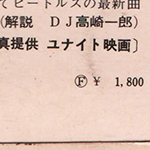 |
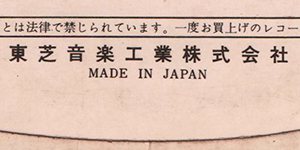 |
Single type.
Full laminated soft cover. Twin-flipback cover (round type). "Toshiba Musical Industries Ltd." and "F-¥1,800" were printed at the bottom of the back cover. |
|||
| LABEL CLOSE UP | |||||
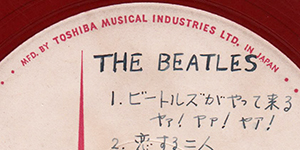 |
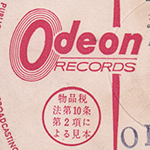 |
Odeon white
label (Test Press and promotional use only). The words "MFD.
BY TOSHIBA MUSICAL INDUSTRIES LTD. IN JAPAN" was printed at
the perimeter. Toshiba pressed a lot of their records on red, "Everclean" vinyl from 1958 through 1974 (maybe). The Everclean vinyl was designed to be less prone to collecting static electricity and dust than the more common black vinyl. |
|||
| LABEL CLOSE UP | |||||
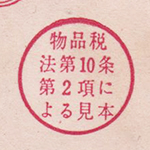 |
Here is a close-up of the circled text:
"Sample under Article 10, Clause 2 of the Commodity Tax
Law". |
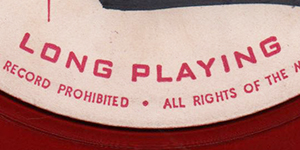 |
The words "LONG PLAYING" was printed at the bottom of the label. | ||
| LABEL CLOSE UP | |||||
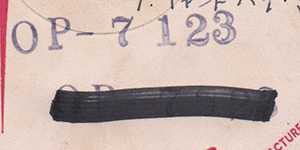 |
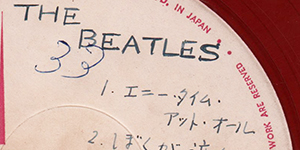 |
A blank version of the Odeon promotional
label was used for test pressing. The catalog number
"OP-7123" was and stamped at the bottom of the label. The
title was handwritten on the label at a later time. |
|||
|
OTHER ITEM
|
|||||
| - | |||||
| RECORD LABEL | Odeon white label (Test press and
promotional use only) |
||||
| MIX | STEREO | ||||
| MATRIX No. | SIDE 1 | YEX-126 3(?) | |||
| SIDE 2 | YEX-127 1 | ||||
| PRESS MARK | H4 |
||||
| VINYL COLOR | RED |
||||
| RECORD COMPANY'S NAME | SLEEVE | Toshiba
Ongaku kogyo Kabusikigaisha |
|||
| LABEL | MFD. BY
TOSHIBA MUSICAL INDUSTRIES LTD. IN JAPAN |
||||
| SYMBOL/PRICE | F - ¥1,800 |
||||
| LYRIC SHEET STYLE | Slip Sheet Type |
||||
| COVER FORM | Single type. Full laminated soft cover. Twin-flipback cover (round type) |
||||
| INNER SLEEVE |
Plain
White Inner bag |
||||
| OBI |
- |
||||
| COVER DESIGN/ PHOTO/ NOTES | Notes: Ichiro Takasaki |
||||
|
COMMENTS
|
Test pressings are
manufacturing samples intended to check the quality of a
record before it is mass-producted. They are produced in very limited quantities and are very rare. They originally were not intended for public distribution. A blank version of the Odeon promotional label was used for test pressing. The catalog number "OP-7123" was and stamped at the bottom of the label. The title was handwritten on the label at a later time. The test pressing was done on red vinyl. According to "The Illustrated Guide To The '60s Japanese LP With Obi (Published by: Shinko Music Entertainment Co., Ltd.)", the inscription area may also contain cutting dates.The press mark can be almost found stamped into the deadwax at the 9 o'clock position of side-1. Most test presses do not have press mark stamped on them, but this test press has a "H4" stamped on it. Red vinyl: Besides good sound and quality printing, Japanese records also offered some other things of interest to the collector. One of the primary manufacturing companies in Japan, Toshiba, pressed a lot of their records on red, “Everclean” vinyl from 1958 through 1974 (maybe). While not pressed as collectors’ items, these red vinyl pressings are more sought out by collectors than their black vinyl counterparts. The Everclean vinyl was designed to be less prone to collecting static electricity and dust than the more common black vinyl. |
||||
| TITLE | A HARD DAY'S NIGHT | ||||
| CATALOG NUMBER | OP-7123 |
||||
| RELEASE DATE | 5th September.1964/First Press |
||||
| TRACK LISTING | SIDE 1 | SIDE 2 | |||
| A Hard Day's Night |
Any Time At All |
||||
| I Should Have Known Better |
I'll Cry Instead |
||||
| If I Fell |
Things We Said Today |
||||
| I'm Happy Just To Dance With You |
When I Get Home |
||||
| And I Love Her |
You Can't Do That |
||||
| Tell Me Why |
I'll Be Back | ||||
| Can't Buy Me Love | |||||
| FRONT --> Click! | BACK --> Click! | SIDE 1 --> Click! | SIDE 2 --> Click! | DISK | |
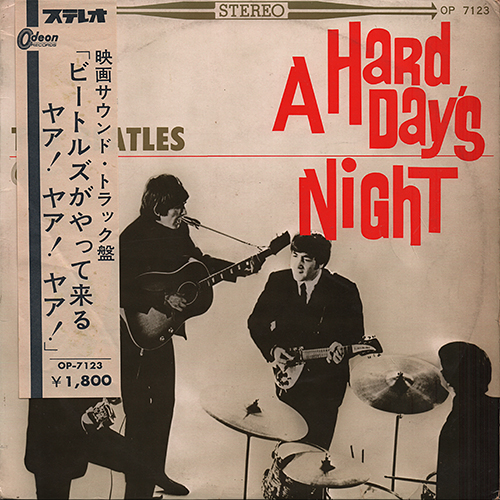 |
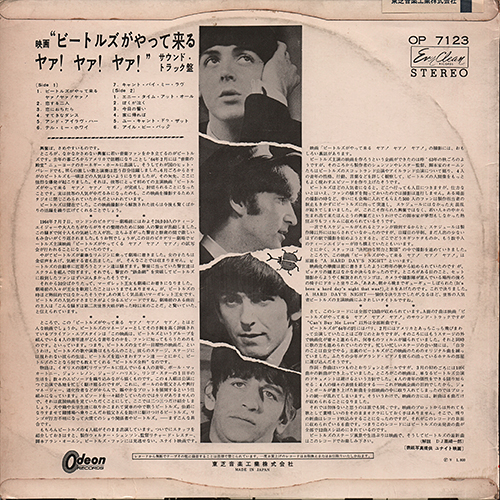 |
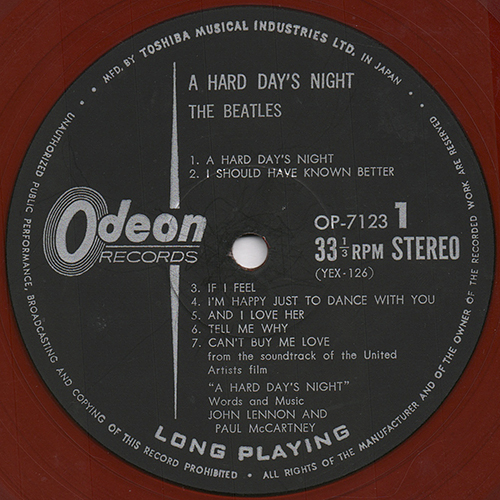 |
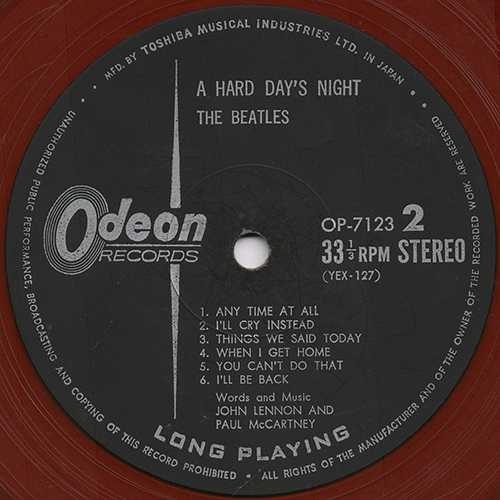 |
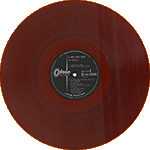 |
|
| INNER SLEEVE |
LYRIC
SHEET (Slip Sheet Type)
|
The
original
plain
white inner bag has a fold-over flap at the top of the bag
to prevent the record from falling out. The lyric sheet is slip sheet type. |
|||
| FRONT --> Click! | BACK --> Click! | FRONT --> Click! | BACK --> Click! | ||
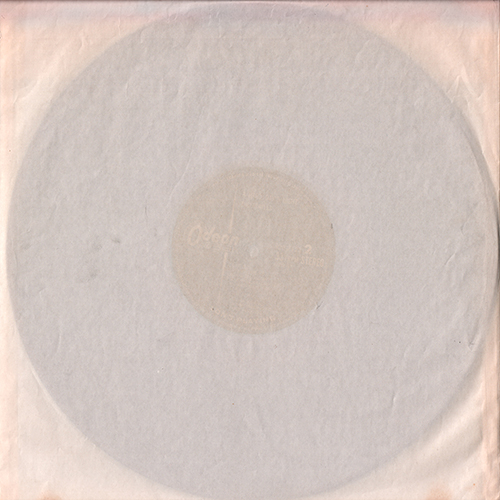 |
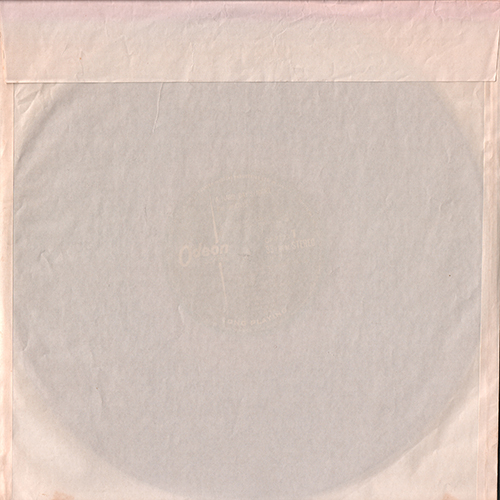 |
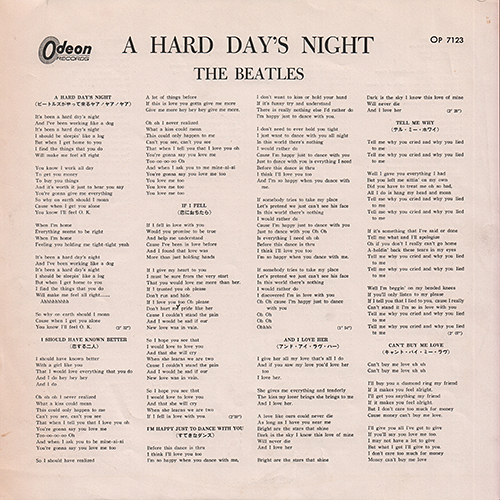 |
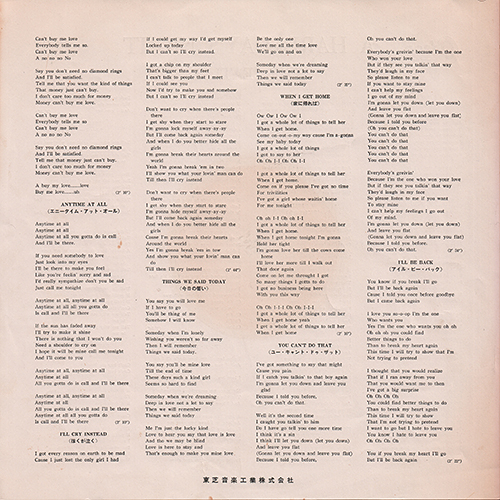 |
||
| LYRIC SHEET CLOSE
UP |
|||||
 |
 |
Catalog number and the company name "Toshiba Musical Industries Ltd." were printed on the lyric sheet. | |||
| "HANKAKE" OBI CLOSE UP | |||||
| FRONT | BACK | ||||
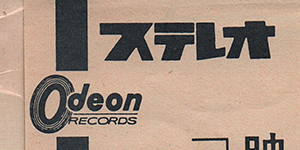 |
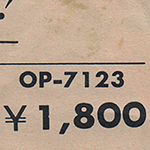 |
 |
|||
| In the early
1960s, a short-lived hankake obi, or “half obi” was used.
These were small strips of paper that simply folded over the
top of the cover. |
|||||
| FRONT COVER CLOSE UP | |||||
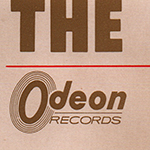 |
 |
 |
|||
| Odeon
logo mark and catalog number "OP 7123" were printed on the
front sleeve. Issues with a "STEREO" banner across the top of the cover. |
|||||
| BACK COVER CLOSE UP | |||||
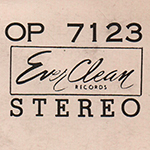 |
Toshiba pressed a lot of their records on red, “Everclean” vinyl. The Everclean vinyl was designed to be less prone to collecting static electricity and dust than the more common black vinyl. | 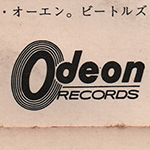 |
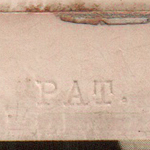 |
Odeon logo mark was
printed at the lower left corner of the back cover. The words "PAT." was embossed at the bottom of the back cover. |
|
| BACK COVER CLOSE UP | |||||
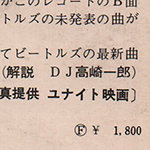 |
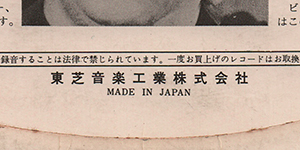 |
Single type.
Full laminated soft cover. Twin-flipback cover (round type). "Toshiba Musical Industries Ltd." and "F-¥1,800" were printed at the bottom of the back cover. |
|||
| LABEL CLOSE UP | |||||
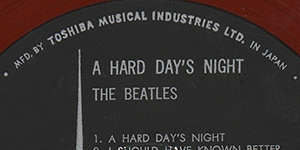 |
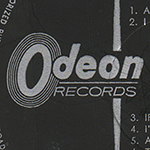 |
Toshiba
pressed a lot of their records on red, "Everclean" vinyl
from 1958 through 1974 (maybe). The Everclean vinyl
was designed to be less prone to collecting static
electricity and dust than the more common black vinyl. The
words "MFD. BY TOSHIBA MUSICAL INDUSTRIES LTD. IN JAPAN" was
printed at the perimeter. |
|||
| LABEL CLOSE UP | |||||
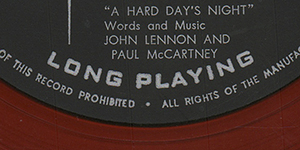 |
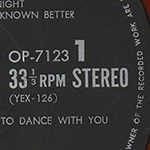 |
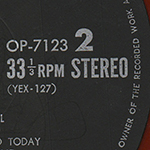 |
The words "LONG PLAYING" was
printed at the bottom of the label. Catalog number and matrix number were printed at the right side of the center hole. |
||
|
OTHER ITEM
|
|||||
| - | |||||
| RECORD LABEL | Odeon Label Type-1 (with the words "LONG
PLAYING") |
||||
| MIX | STEREO | ||||
| MATRIX No. | SIDE 1 | YEX 126 - 4 | |||
| SIDE 2 | YEX 127 - 11 | ||||
| PRESS MARK | H4 |
||||
| VINYL COLOR | RED |
||||
| RECORD COMPANY'S NAME | SLEEVE | Toshiba
Ongaku
kogyo Kabusikigaisha |
|||
| LABEL | MFD. BY
TOSHIBA MUSICAL INDUSTRIES LTD. IN JAPAN |
||||
| SYMBOL/PRICE | F - ¥1,800 |
||||
| LYRIC SHEET STYLE | Slip Sheet Type |
||||
| COVER FORM | Single type. Full laminated soft cover. Twin-flipback cover (round type) |
||||
| INNER SLEEVE |
Plain
White
Inner bag |
||||
| OBI |
"Hankake" Obi White in design with dark blue Japanese text. Obis draped from the top, not forming a loop. |
||||
| COVER DESIGN/ PHOTO/ NOTES | Notes: Ichiro Takasaki |
||||
|
COMMENTS
|
Black Odeon label with
silver print. The words "LONG PLAYING" was printed at the bottom of the label. Toshiba released the first Japanese record featuring the Beatles. When this record was released in 1964, Toshiba's official name was "Toshiba Musical Industries Ltd." and they used the Odeon label for this and subsequent Beatles releases. Red vinyl: Besides good sound and quality printing, Japanese records also offered some other things of interest to the collector. One of the primary manufacturing companies in Japan, Toshiba, pressed a lot of their records on red, “Everclean” vinyl from 1958 through 1974 (maybe). While not pressed as collectors’ items, these red vinyl pressings are more sought out by collectors than their black vinyl counterparts. The Everclean vinyl was designed to be less prone to collecting static electricity and dust than the more common black vinyl. The obi: A. K. A."Hankake" Obi It is made from very thin paper stock. It is white in design with dark blue Japanese text. It also features an Odeon logo, catalogue number and price information. While most Japanese records feature local music, a lot of music fans there like foreign music, as well. The language barrier in Japan presented a problem – should foreign album covers be changed for Japanese albums? The solution was the obi, which means “belt” or “sash”. The obi is a strip of paper, usually about two inches wide, that wraps vertically around the album cover, containing information about the artist and album in Japanese. As these strips of paper were fragile and easily torn, they are often missing, especially since consumers in the 1950s and 1960s attached little significance to them. Finding Japanese records made prior to 1970 that still have the obi intact can be quite difficult, and for some albums, nearly impossible. The inclusion of the obi can dramatically affect the price of some Japanese records, sometimes increasing the price by a factor of ten. While usually found in a wraparound strip, there are other versions of the obi that have occasionally been used. In the early 1960s, a short-lived hankake obi, or “half obi” was used. These were small strips of paper that simply folded over the top of the cover. These were problematic for retailers, as they tended to easily fall off of the record. |
||||
| TITLE | A HARD DAY'S NIGHT | ||||
| CATALOG NUMBER | OP-7123 |
||||
| RELEASE DATE | April 1967? / Third Press |
||||
| TRACK LISTING | SIDE 1 | SIDE 2 | |||
| A Hard Day's Night |
Any Time At All |
||||
| I Should Have Known Better |
I'll Cry Instead |
||||
| If I Fell |
Things We Said Today |
||||
| I'm Happy Just To Dance With You |
When I Get Home |
||||
| And I Love Her |
You Can't Do That |
||||
| Tell Me Why |
I'll Be Back | ||||
| Can't Buy Me Love | |||||
| FRONT --> Click! | BACK --> Click! | SIDE 1 --> Click! | SIDE 2 --> Click! | DISK | |
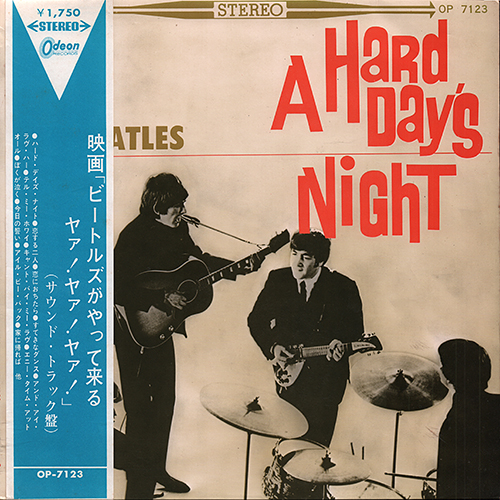 |
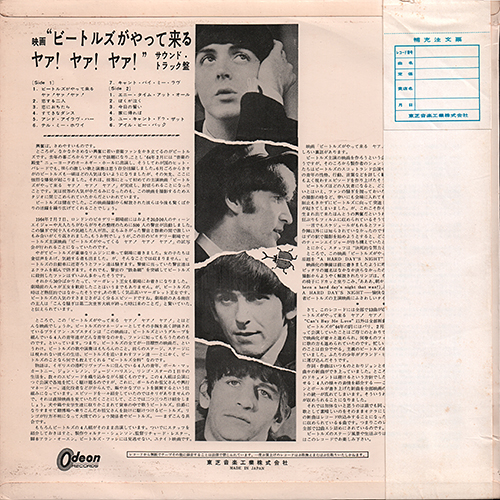 |
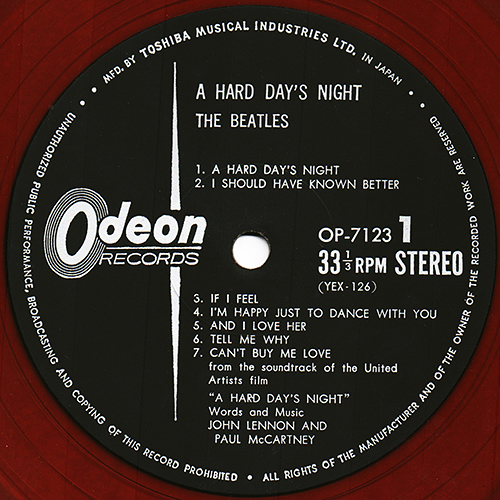 |
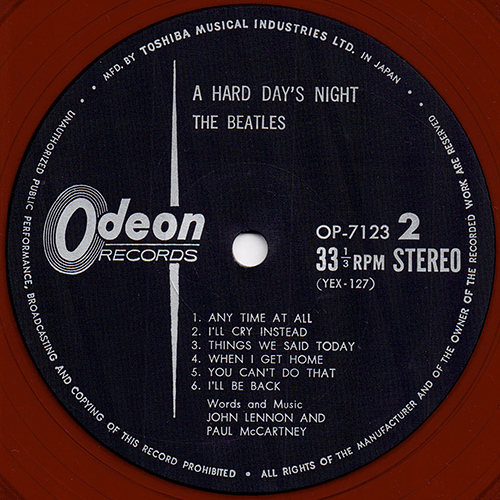 |
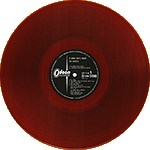 |
|
| INNER SLEEVE |
LYRIC
SHEET (Slip Sheet Type)
|
The
original
colour "advert" inner bag has a fold-over flap at the top of
the bag to prevent the record from falling out. The lyric sheet is slip sheet type. |
|||
| FRONT --> Click! | BACK --> Click! | FRONT --> Click! | BACK --> Click! | ||
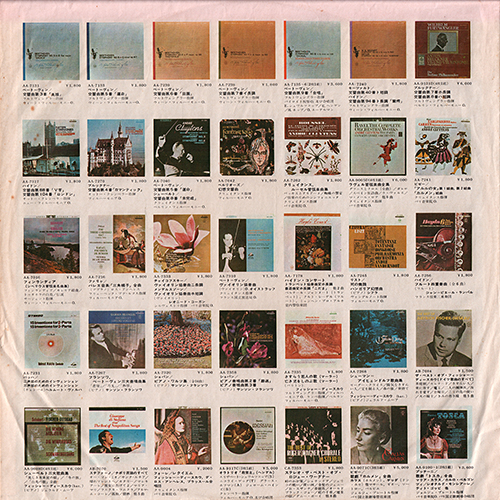 |
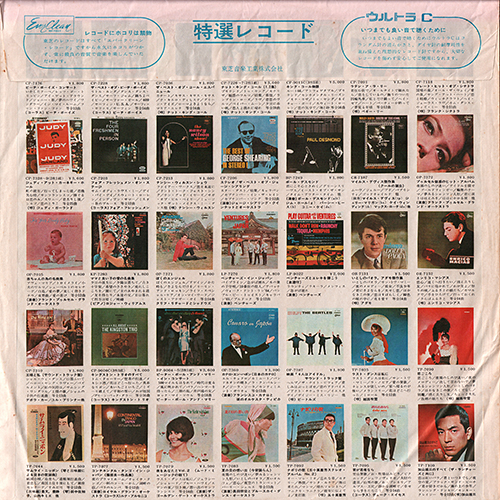 |
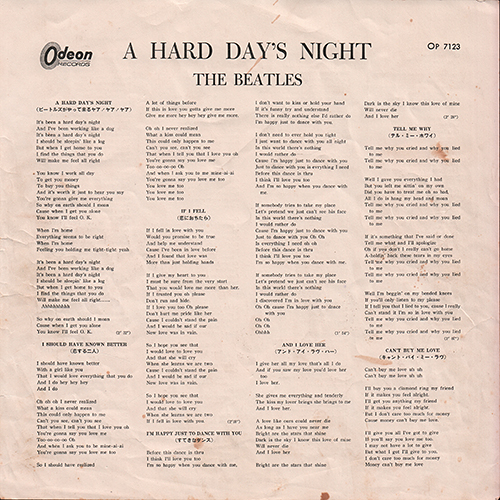 |
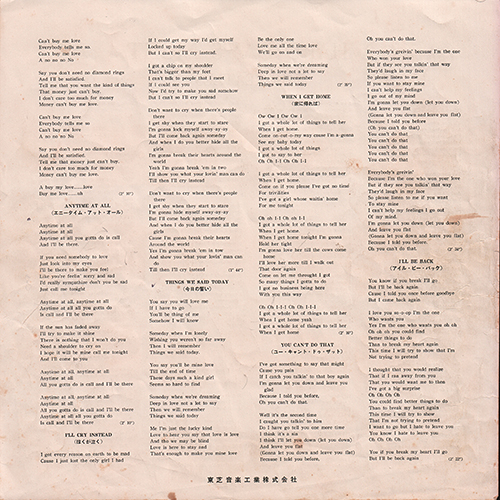 |
||
| INNER SLEEVE CLOSE UP |
LYRIC SHEET CLOSE UP | ||||
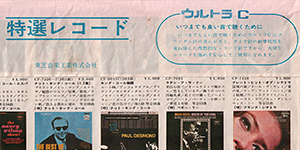 |
 |
 |
|||
| Catalog number and the company name "Toshiba Musical Industries Ltd." were printed on the lyric sheet. | |||||
| "LIGHT BLUE" OBI CLOSE UP | |||||
| FRONT | BACK --> Click! | ||||
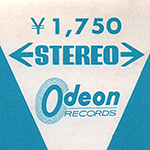 |
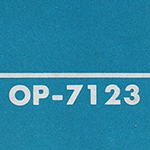 |
2nd. pressing had a light blue / white so called "Sankaku"(triangle) or "V-shape" OBI and priced ¥1750 on rear sleeve and obi strip. | 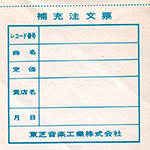 |
The obi remains intactwith
the order form on the back uncut. |
|
| FRONT COVER CLOSE UP | |||||
 |
 |
 |
|||
| Odeon
logo mark and catalog number "OP 7123" were printed on the
front sleeve. Issues with a "STEREO" banner across the top of the cover. |
|||||
| BACK COVER CLOSE UP | |||||
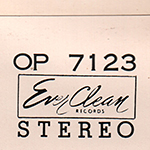 |
Toshiba pressed a lot of their records on red, “Everclean” vinyl. The Everclean vinyl was designed to be less prone to collecting static electricity and dust than the more common black vinyl. | 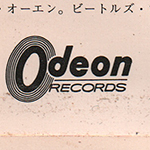 |
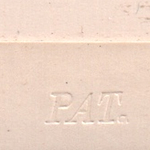 |
Odeon logo mark was
printed at the lower left corner of the back cover. The words "PAT. (italic type)" was embossed at the bottom of the back cover. |
|
| BACK COVER CLOSE UP | |||||
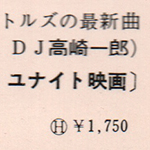 |
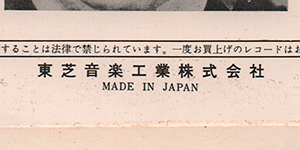 |
Single type.
Full laminated soft cover. Twin-flipback cover (straight type). "Toshiba Musical Industries Ltd." and "H-¥1,750" were printed at the bottom of the back cover. |
|||
| LABEL CLOSE UP | |||||
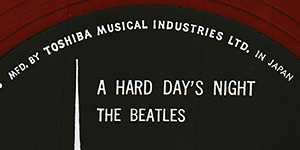 |
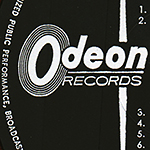 |
Toshiba
pressed a lot of their records on red, "Everclean" vinyl
from 1958 through 1974 (maybe). The Everclean vinyl
was designed to be less prone to collecting static
electricity and dust than the more common black vinyl. The
words "MFD. BY TOSHIBA MUSICAL INDUSTRIES LTD. IN JAPAN" was
printed at the perimeter. |
|||
| LABEL CLOSE UP | |||||
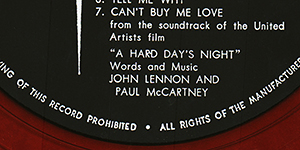 |
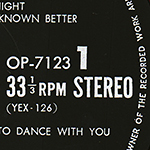 |
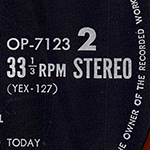 |
The words "LONG PLAYING" was erased at the bottom of
the label. Catalog number and matrix number were printed at the right side of the center hole. |
||
|
OTHER ITEM
|
|||||
| - | |||||
| RECORD LABEL | Odeon Label Type-2 (without the words "LONG
PLAYING") |
||||
| MIX | STEREO | ||||
| MATRIX No. | SIDE 1 | YEX 126 - 21 6 | |||
| SIDE 2 | YEX 127 - 3 8 | ||||
| PRESS MARK | 7B
-> 7C -> 7D |
||||
| VINYL COLOR | RED |
||||
| RECORD COMPANY'S NAME | SLEEVE | Toshiba
Ongaku kogyo Kabusikigaisha |
|||
| LABEL | MFD. BY
TOSHIBA MUSICAL INDUSTRIES LTD. IN JAPAN |
||||
| SYMBOL/PRICE | H -
¥1,750 |
||||
| LYRIC SHEET STYLE | Slip Sheet Type |
||||
| COVER FORM | Single type. Full laminated soft cover. Twin-flipback cover (straight type) |
||||
| INNER SLEEVE |
The
original colour "advert" inner bag Type-4 |
||||
| OBI |
Light blue / white so called "Sankaku" (triangle) or "V-shape" OBI | ||||
| COVER DESIGN/ PHOTO/ NOTES | Notes: Ichiro Takasaki |
||||
|
COMMENTS
|
Black Odeon label with
silver print. The words "LONG PLAYING" was erased at the bottom of the label. Toshiba released the first Japanese record featuring the Beatles. When this record was released, Toshiba's official name was "Toshiba Musical Industries Ltd." and they used the Odeon label for this and subsequent Beatles releases. Red vinyl: Besides good sound and quality printing, Japanese records also offered some other things of interest to the collector. One of the primary manufacturing companies in Japan, Toshiba, pressed a lot of their records on red, “Everclean” vinyl from 1958 through 1974 (maybe). While not pressed as collectors’ items, these red vinyl pressings are more sought out by collectors than their black vinyl counterparts. The Everclean vinyl was designed to be less prone to collecting static electricity and dust than the more common black vinyl. The obi: A. K. A."V-shape" Obi 2nd. pressing had a light blue/white so called "Sankaku"(triangle) or "V-shape" OBI and priced ¥1750 on rear sleeve and obi strip. It also features an Odeon logo, catalogue number and price information. Only issued briefly in 1966 August till November. Soon, price changed ¥2,000 (stickered on old price, subsequently printed on rear sleeve) with different obi (green arrow obi) and different catalog number (OP-8147). While most Japanese records feature local music, a lot of music fans there like foreign music, as well. The language barrier in Japan presented a problem – should foreign album covers be changed for Japanese albums? The solution was the obi, which means “belt” or “sash”. The obi is a strip of paper, usually about two inches wide, that wraps vertically around the album cover, containing information about the artist and album in Japanese. As these strips of paper were fragile and easily torn, they are often missing, especially since consumers in the 1950s and 1960s attached little significance to them. Finding Japanese records made prior to 1970 that still have the obi intact can be quite difficult, and for some albums, nearly impossible. The inclusion of the obi can dramatically affect the price of some Japanese records, sometimes increasing the price by a factor of ten. |
||||
| TITLE | A HARD DAY'S NIGHT | ||||
| CATALOG NUMBER | OP-8147 |
||||
| RELEASE DATE | September 1967? / 4th. Press |
||||
| TRACK LISTING | SIDE 1 | SIDE 2 | |||
| A Hard Day's Night |
Any Time At All |
||||
| I Should Have Known Better |
I'll Cry Instead |
||||
| If I Fell |
Things We Said Today |
||||
| I'm Happy Just To Dance With You |
When I Get Home |
||||
| And I Love Her |
You Can't Do That |
||||
| Tell Me Why |
I'll Be Back | ||||
| Can't Buy Me Love | |||||
| FRONT --> Click! | BACK --> Click! | SIDE 1 --> Click! | SIDE 2 --> Click! | DISK | |
 |
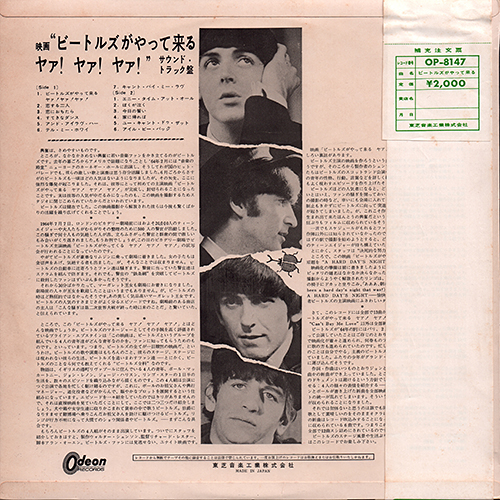 |
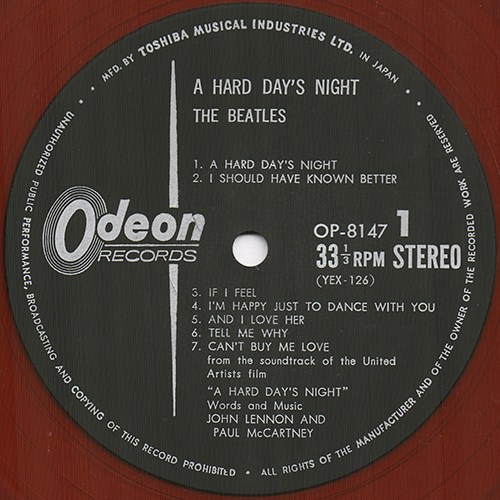 |
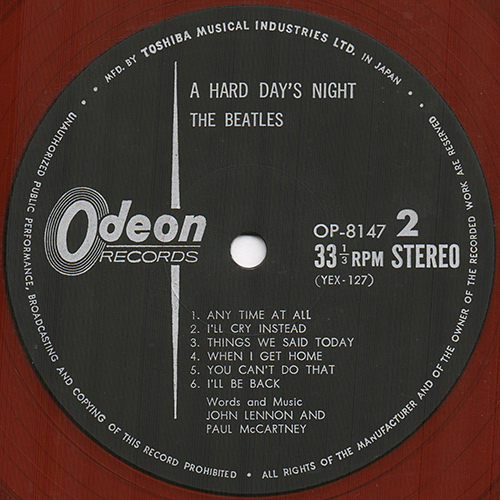 |
 |
|
| INNER SLEEVE |
LYRIC
SHEET (Slip Sheet Type)
|
The
original
colour "advert" inner bag has a fold-over flap at the top of
the bag to prevent the record from falling out. The lyric sheet is slip sheet type. |
|||
| FRONT --> Click! | BACK --> Click! | FRONT --> Click! | BACK --> Click! | ||
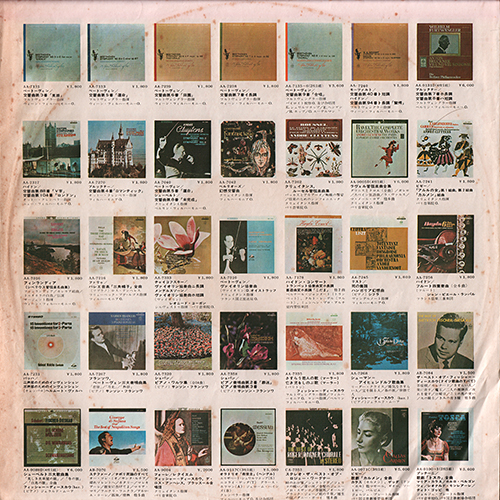 |
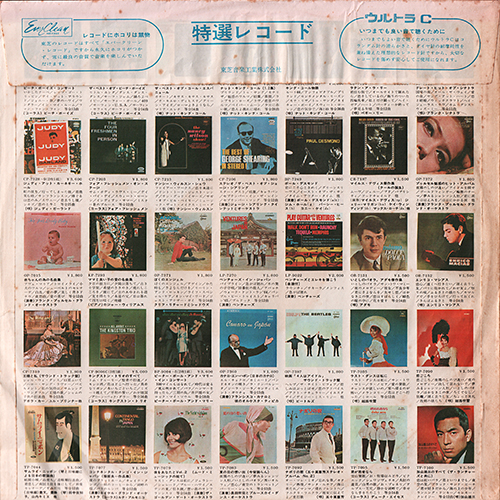 |
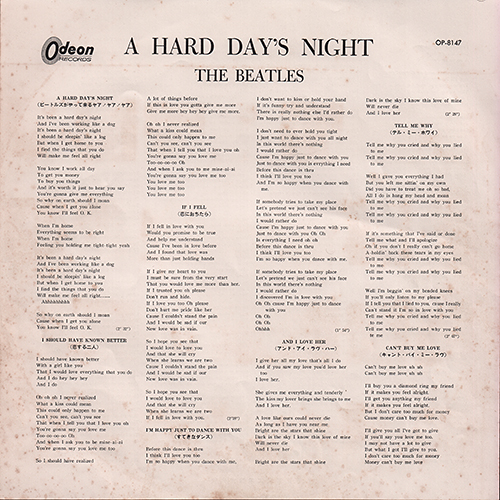 |
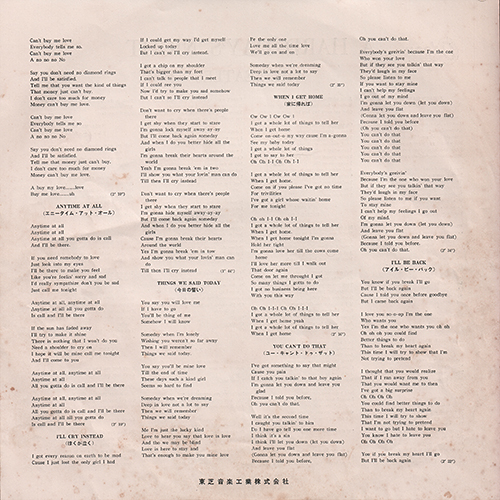 |
||
| INNER SLEEVE CLOSE UP |
LYRIC SHEET CLOSE UP | ||||
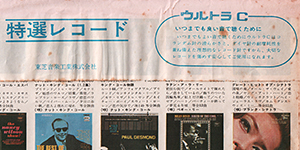 |
 |
 |
|||
| Catalog number "OP-8147" and the company name "Toshiba Musical Industries Ltd." were printed on the lyric sheet. | |||||
| Odeon Green Arrow OBI CLOSE UP | |||||
| FRONT | BACK --> Click! | ||||
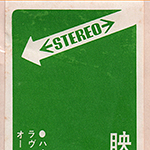 |
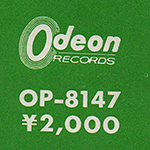 |
4th. pressing had a green "arrow" OBI and priced ¥2,000 on rear sleeve and obi strip. | 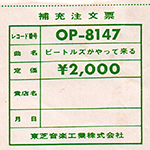 |
The obi remains intactwith
the order form on the back uncut. |
|
| FRONT COVER CLOSE UP | |||||
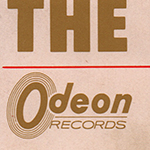 |
Odeon
logo
mark was printed at the left side of the front sleeve. |
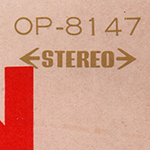 |
Catalog number
"OP-8147" were printed on the front sleeve. This version does not have the word "STEREO" across the top front cover, as does OP-7123. |
||
| BACK COVER CLOSE UP | |||||
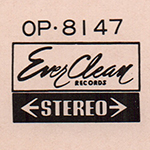 |
Toshiba pressed a lot of their records on red, “Everclean” vinyl. The Everclean vinyl was designed to be less prone to collecting static electricity and dust than the more common black vinyl. | 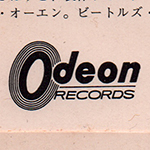 |
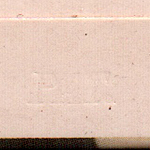 |
Odeon logo mark was
printed at the lower left corner of the back cover. The words "PAT. (italic type)" was embossed at the bottom of the back cover. |
|
| BACK COVER CLOSE UP | |||||
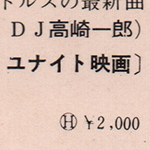 |
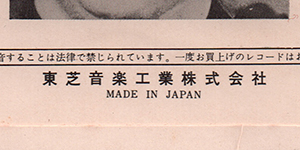 |
Single type.
Full laminated soft cover. Twin-flipback cover (straight type). "Toshiba Musical Industries Ltd." and "H-¥2,000" were printed at the bottom of the back cover. |
|||
| LABEL CLOSE UP | |||||
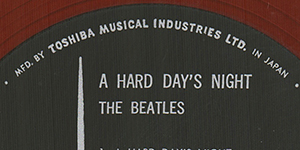 |
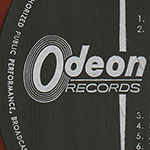 |
Toshiba
pressed a lot of their records on red, "Everclean" vinyl
from 1958 through 1974 (maybe). The Everclean vinyl
was designed to be less prone to collecting static
electricity and dust than the more common black vinyl. The
words "MFD. BY TOSHIBA MUSICAL INDUSTRIES LTD. IN JAPAN" was
printed at the perimeter. |
|||
| LABEL CLOSE UP | |||||
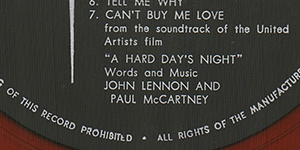 |
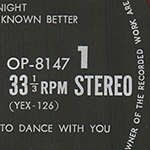 |
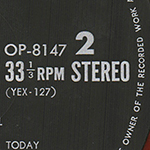 |
The words "LONG PLAYING" was erased at the bottom of
the label. Catalog number "OP-8147" and matrix number were printed at the right side of the center hole. |
||
|
OTHER ITEM
|
|||||
| - | |||||
| RECORD LABEL | Odeon Label Type-2 (without the words "LONG
PLAYING") |
||||
| MIX | STEREO | ||||
| MATRIX No. | SIDE 1 | YEX 126 -21 8 | |||
| SIDE 2 | YEX 127 -3 9 | ||||
| PRESS MARK | 7E
-> 7J |
||||
| VINYL COLOR | RED |
||||
| RECORD COMPANY'S NAME | SLEEVE | Toshiba
Ongaku kogyo Kabusikigaisha |
|||
| LABEL | MFD. BY
TOSHIBA MUSICAL INDUSTRIES LTD. IN JAPAN |
||||
| SYMBOL/PRICE | H -
¥2,000 |
||||
| LYRIC SHEET STYLE | Slip Sheet Type |
||||
| COVER FORM | Single type. Full laminated soft cover. Twin-flipback cover (straight type) |
||||
| INNER SLEEVE |
The
original colour "advert" inner bag Type-4 |
||||
| OBI |
Green / white so called "Odeon Arrow" OBI |
||||
| COVER DESIGN/ PHOTO/ NOTES | Notes: Ichiro Takasaki |
||||
|
COMMENTS
|
Black Odeon label with
silver print. The words "LONG PLAYING" was erased at the bottom of the label. Taking advantage of the rise in LP prices in 1967, the price of a stereo LP rose to 2,000 yen. Already released Beatles LPs have been reissued with the record number changed to OP-8,000, and the obi changed to an arrow obi. The alphabet symbol and price display on the back of the cover have also been changed to "H ¥2,000". Red vinyl: Besides good sound and quality printing, Japanese records also offered some other things of interest to the collector. One of the primary manufacturing companies in Japan, Toshiba, pressed a lot of their records on red, “Everclean” vinyl from 1958 through 1974 (maybe). While not pressed as collectors’ items, these red vinyl pressings are more sought out by collectors than their black vinyl counterparts. The Everclean vinyl was designed to be less prone to collecting static electricity and dust than the more common black vinyl. The obi: A. K. A."Arrow" Obi 4th. pressing had a green / white so called "Arrow" OBI and priced ¥2000 on rear sleeve and obi strip. On June 1967, starting with "Oldies (OP-8016)", numbering for new Odeon LPs changed to the 8000 range numbers. So Obis were renew, A.K.A. Odeon "Arrow Obi" in green and with the same design as the Apple Obis. While most Japanese records feature local music, a lot of music fans there like foreign music, as well. The language barrier in Japan presented a problem – should foreign album covers be changed for Japanese albums? The solution was the obi, which means “belt” or “sash”. The obi is a strip of paper, usually about two inches wide, that wraps vertically around the album cover, containing information about the artist and album in Japanese. As these strips of paper were fragile and easily torn, they are often missing, especially since consumers in the 1950s and 1960s attached little significance to them. Finding Japanese records made prior to 1970 that still have the obi intact can be quite difficult, and for some albums, nearly impossible. The inclusion of the obi can dramatically affect the price of some Japanese records, sometimes increasing the price by a factor of ten. |
||||
| TITLE | A HARD DAY'S NIGHT | ||||
| CATALOG NUMBER | AP-8147 |
||||
| RELEASE DATE | October 1969? / 4th. Press |
||||
| TRACK LISTING | SIDE 1 | SIDE 2 | |||
| A Hard Day's Night |
Any Time At All |
||||
| I Should Have Known Better |
I'll Cry Instead |
||||
| If I Fell |
Things We Said Today |
||||
| I'm Happy Just To Dance With You |
When I Get Home |
||||
| And I Love Her |
You Can't Do That |
||||
| Tell Me Why |
I'll Be Back | ||||
| Can't Buy Me Love | |||||
| FRONT --> Click! | BACK --> Click! | SIDE 1 --> Click! | SIDE 2 --> Click! | DISK | |
 |
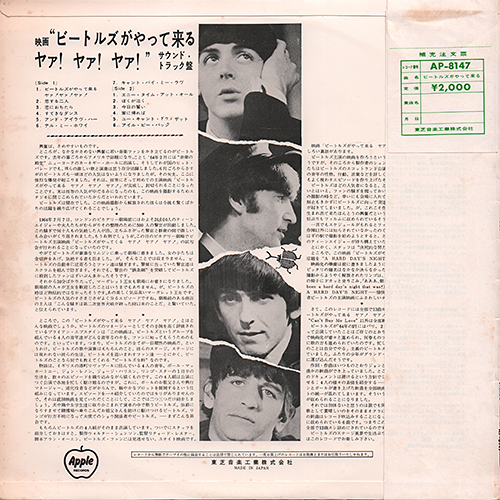 |
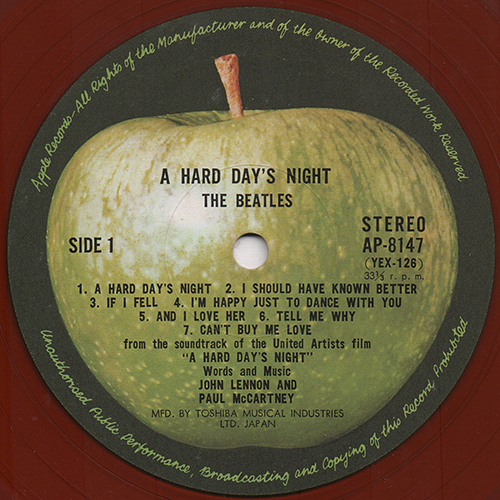 |
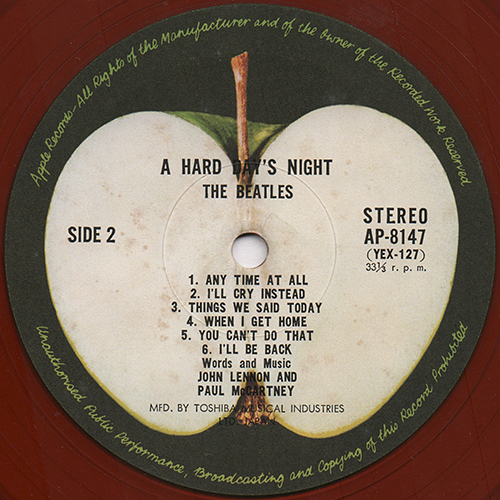 |
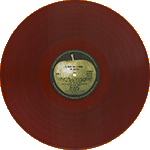 |
|
| INNER SLEEVE |
LYRIC
SHEET (Slip Sheet Type)
|
With
Apple
custom black inner sleeve. The lyric sheet is slip sheet type. |
|||
| FRONT --> Click! | BACK --> Click! | FRONT --> Click! | BACK --> Click! | ||
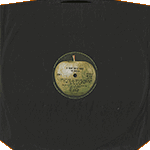 |
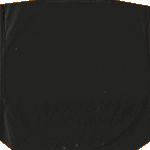 |
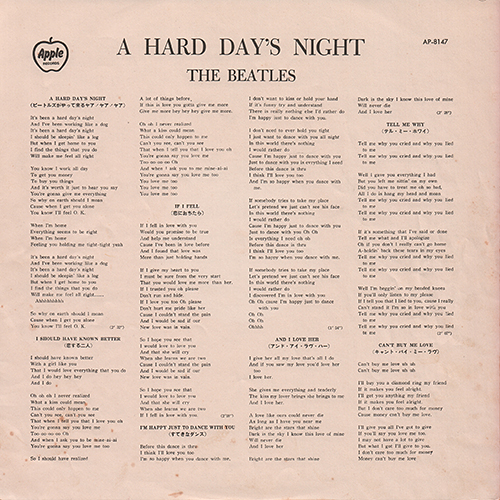 |
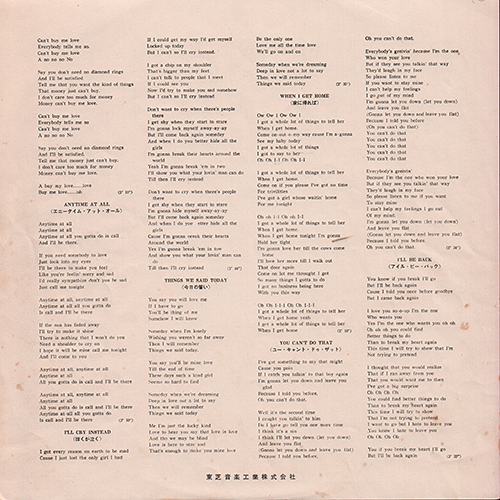 |
||
| INNER SLEEVE CLOSE UP |
LYRIC SHEET CLOSE UP | ||||
 |
 |
Catalog number "AP-8147" and the company name "Toshiba Musical Industries Ltd." were printed on the lyric sheet. | |||
| Apple Green Arrow OBI CLOSE UP | |||||
| FRONT | BACK --> Click! | ||||
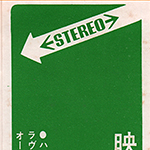 |
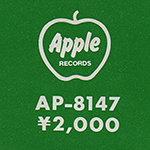 |
5th. pressing had a Apple "arrow" OBI and priced ¥2,000 on rear sleeve and obi strip. | 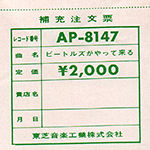 |
The obi remains intactwith
the order form on the back uncut. |
|
| FRONT COVER CLOSE UP | |||||
 |
Apple
logo
mark was printed at the left side of the front sleeve. |
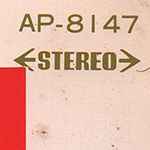 |
Catalog number
"AP-8147" were printed on the front sleeve. This version does not have the word "STEREO" across the top front cover, as does OP-7123. |
||
| BACK COVER CLOSE UP | |||||
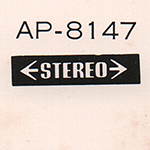 |
"Ever Clean" logo mark was
removed on the back cover. |
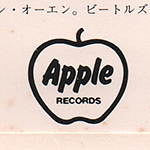 |
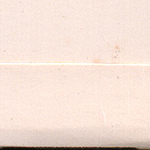 |
Apple logo mark was
printed at the lower left corner of the back cover. The words "PAT." was removed at the bottom of the back cover. |
|
| BACK COVER CLOSE UP | |||||
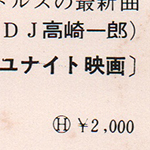 |
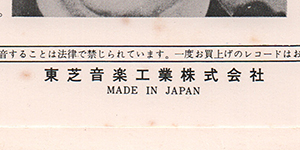 |
Single type.
Full laminated soft cover. Twin-flipback cover (straight type). "Toshiba Musical Industries Ltd." and "H-¥2,000" were printed at the bottom of the back cover. |
|||
| LABEL CLOSE UP | |||||
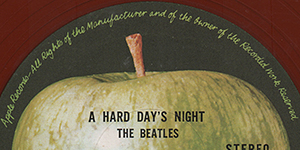 |
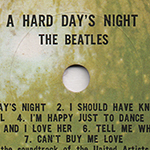 |
In 1969,
Toshiba had to reissue on the Apple label all the records
previously issued on the Odeon label. The phrase "Apple Records - All Rights of the Manufacturer and of the Owner of the Recorded work Reserved." was printed at the perimeter. |
|||
| LABEL CLOSE UP | |||||
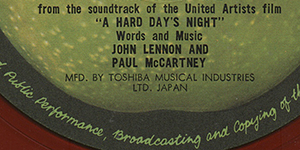 |
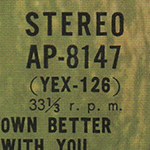 |
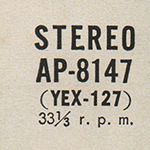 |
The words "MFD. BY TOSHIBA
MUSICAL INDUSTRIES LTD. JAPAN" was printed at the bottom of
the label. Catalog number "AP-8147" and matrix number were printed at the right side of the center hole. |
||
|
OTHER ITEM
|
|||||
| - | |||||
| RECORD LABEL | Dark Green Apple label Type-1 |
||||
| MIX | STEREO | ||||
| MATRIX No. | SIDE 1 | YEX 126 -21 16 | |||
| SIDE 2 | YEX 127 -3 22 | ||||
| PRESS MARK | 9K |
||||
| VINYL COLOR | RED |
||||
| RECORD COMPANY'S NAME | SLEEVE | Toshiba
Ongaku kogyo Kabusikigaisha |
|||
| LABEL | MFD. BY
TOSHIBA MUSICAL INDUSTRIES LTD. JAPAN |
||||
| SYMBOL/PRICE | H -
¥2,000 |
||||
| LYRIC SHEET STYLE | Slip Sheet Type |
||||
| COVER FORM | Single type. Full laminated soft cover. Twin-flipback cover (straight type) |
||||
| INNER SLEEVE |
Apple custom black sleeve |
||||
| OBI |
Green / white so called "Apple Arrow" OBI |
||||
| COVER DESIGN/ PHOTO/ NOTES | Notes: Ichiro Takasaki |
||||
|
COMMENTS
|
Dark green Apple label
Type-1with black print. In late (September?)1969, Toshiba had to reissue on the Apple label all the records previously issued on the Odeon label. And in the Apple label, there are two subtypes, TOSHIBA MUSIC and TOSHIBA EMI. Further more, the early copies of the APPLE-TOSHIBA MUSIC type have dark Apple on its label, though the late copies have light one. Red vinyl: Besides good sound and quality printing, Japanese records also offered some other things of interest to the collector. One of the primary manufacturing companies in Japan, Toshiba, pressed a lot of their records on red, “Everclean” vinyl from 1958 through 1974 (maybe). While not pressed as collectors’ items, these red vinyl pressings are more sought out by collectors than their black vinyl counterparts. The Everclean vinyl was designed to be less prone to collecting static electricity and dust than the more common black vinyl. This LP was manufactured two ways: both Black and Red vinyl. The obi: A. K. A."Arrow" Obi 4th. and 5th. pressings had a green / white so called "Arrow" OBI and priced ¥2000 on rear sleeve and obi strip. On June 1967, starting with "Oldies (OP-8016)", numbering for new Odeon LPs changed to the 8000 range numbers. So Obis were renew, A.K.A. Odeon "Arrow Obi" in green and with the same design as the Apple Obis. While most Japanese records feature local music, a lot of music fans there like foreign music, as well. The language barrier in Japan presented a problem – should foreign album covers be changed for Japanese albums? The solution was the obi, which means “belt” or “sash”. The obi is a strip of paper, usually about two inches wide, that wraps vertically around the album cover, containing information about the artist and album in Japanese. As these strips of paper were fragile and easily torn, they are often missing, especially since consumers in the 1950s and 1960s attached little significance to them. Finding Japanese records made prior to 1970 that still have the obi intact can be quite difficult, and for some albums, nearly impossible. The inclusion of the obi can dramatically affect the price of some Japanese records, sometimes increasing the price by a factor of ten. |
||||
| TITLE | A HARD DAY'S NIGHT | ||||
| CATALOG NUMBER | AP-8147 |
||||
| RELEASE DATE | February 1971? / 4th. Press |
||||
| TRACK LISTING | SIDE 1 | SIDE 2 | |||
| A Hard Day's Night |
Any Time At All |
||||
| I Should Have Known Better |
I'll Cry Instead |
||||
| If I Fell |
Things We Said Today |
||||
| I'm Happy Just To Dance With You |
When I Get Home |
||||
| And I Love Her |
You Can't Do That |
||||
| Tell Me Why |
I'll Be Back | ||||
| Can't Buy Me Love | |||||
| FRONT --> Click! | BACK --> Click! | SIDE 1 --> Click! | SIDE 2 --> Click! | DISK | |
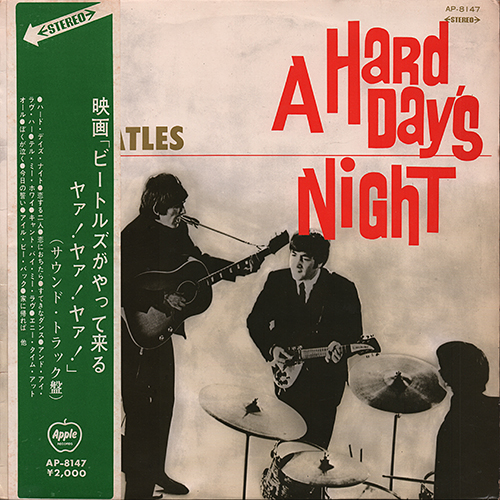 |
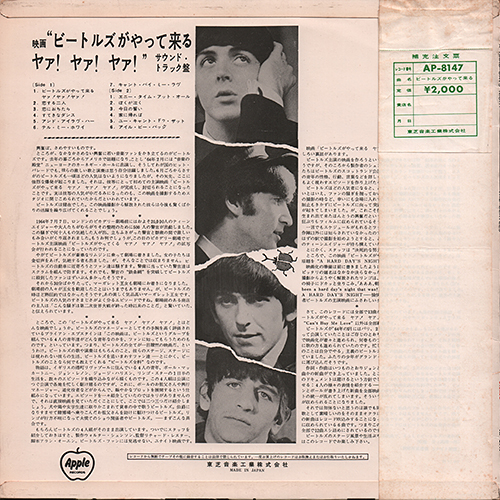 |
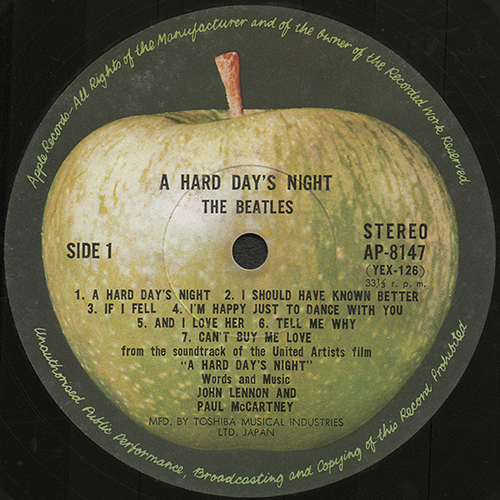 |
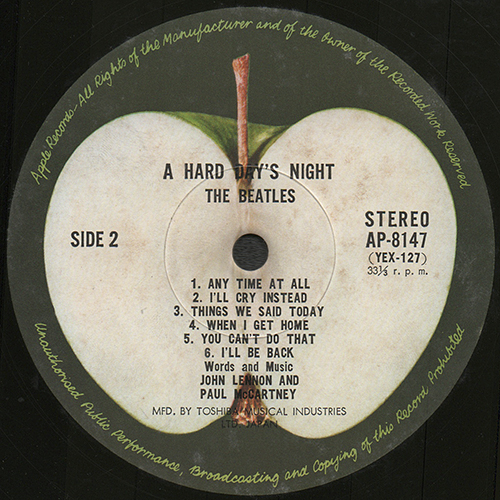 |
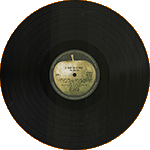 |
|
| INNER SLEEVE |
LYRIC
SHEET (Slip Sheet Type)
|
With
Apple
custom black inner sleeve. The lyric sheet is slip sheet type. |
|||
| FRONT --> Click! | BACK --> Click! | FRONT --> Click! | BACK --> Click! | ||
 |
 |
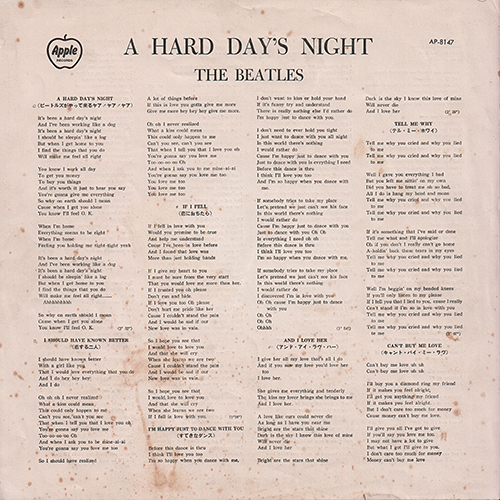 |
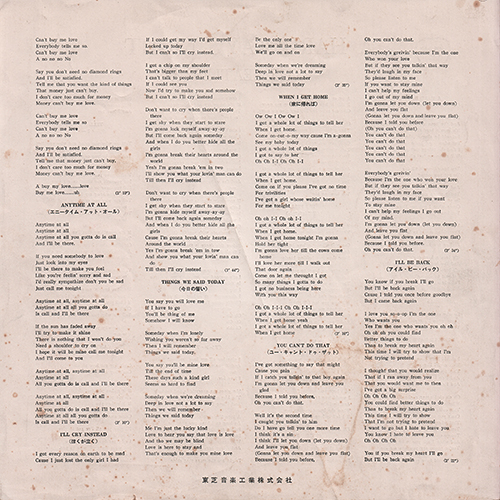 |
||
| INNER SLEEVE CLOSE UP |
LYRIC SHEET CLOSE UP | ||||
 |
 |
Catalog number "AP-8147" and the company name "Toshiba Musical Industries Ltd." were printed on the lyric sheet. | |||
| Apple Green Arrow OBI CLOSE UP | |||||
| FRONT | BACK --> Click! | ||||
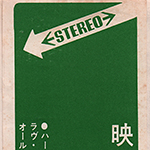 |
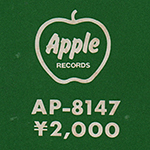 |
5th. pressing had a Apple "arrow" OBI and priced ¥2,000 on rear sleeve and obi strip. | 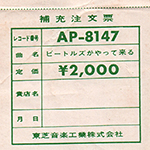 |
The obi remains intactwith
the order form on the back uncut. |
|
| FRONT COVER CLOSE UP | |||||
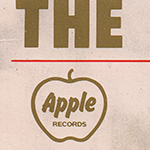 |
Apple
logo
mark was printed at the left side of the front sleeve. |
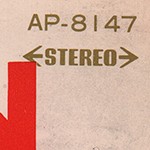 |
Catalog number
"AP-8147" were printed on the front sleeve. This version does not have the word "STEREO" across the top front cover, as does OP-7123. |
||
| BACK COVER CLOSE UP | |||||
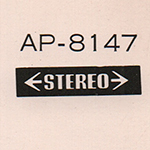 |
"Ever Clean" logo mark was
removed on the back cover. |
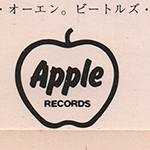 |
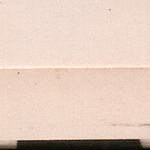 |
Apple logo mark was
printed at the lower left corner of the back cover. The words "PAT." was removed at the bottom of the back cover. |
|
| BACK COVER CLOSE UP | |||||
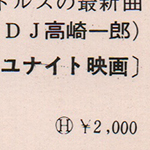 |
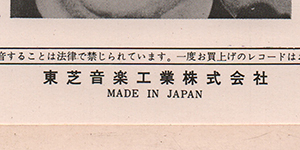 |
Single type.
Full laminated soft cover. Twin-flipback cover (straight type). "Toshiba Musical Industries Ltd." and "H-¥2,000" were printed at the bottom of the back cover. |
|||
| LABEL CLOSE UP | |||||
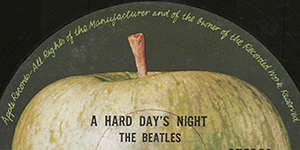 |
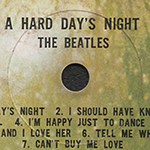 |
In 1969,
Toshiba had to reissue on the Apple label all the records
previously issued on the Odeon label. The phrase "Apple Records - All Rights of the Manufacturer and of the Owner of the Recorded work Reserved." was printed at the perimeter. |
|||
| LABEL CLOSE UP | |||||
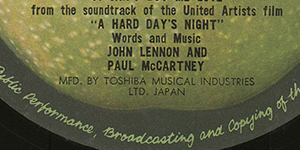 |
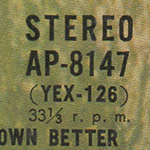 |
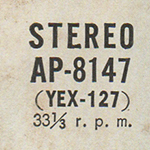 |
The words "MFD. BY TOSHIBA
MUSICAL INDUSTRIES LTD. JAPAN" was printed at the bottom of
the label. Catalog number "AP-8147" and matrix number were printed at the right side of the center hole. |
||
|
OTHER ITEM
|
|||||
| - | |||||
| RECORD LABEL | Dark Green Apple label Type-1 |
||||
| MIX | STEREO | ||||
| MATRIX No. | SIDE 1 | YEX 126 -21 22 | |||
| SIDE 2 | YEX 127 -3 31 | ||||
| PRESS MARK | 1B |
||||
| VINYL COLOR | BLACK |
||||
| RECORD COMPANY'S NAME | SLEEVE | Toshiba
Ongaku kogyo Kabusikigaisha |
|||
| LABEL | MFD. BY
TOSHIBA MUSICAL INDUSTRIES LTD. JAPAN |
||||
| SYMBOL/PRICE | H -
¥2,000 |
||||
| LYRIC SHEET STYLE | Slip Sheet Type |
||||
| COVER FORM | Single type. Full laminated soft cover. Twin-flipback cover (straight type) |
||||
| INNER SLEEVE |
Apple custom black sleeve |
||||
| OBI |
Green / white so called "Apple Arrow" OBI |
||||
| COVER DESIGN/ PHOTO/ NOTES | Notes: Ichiro Takasaki |
||||
|
COMMENTS
|
Dark green Apple label
Type-1with black print. Black vinyl. In late (September?)1969, Toshiba had to reissue on the Apple label all the records previously issued on the Odeon label. And in the Apple label, there are two subtypes, TOSHIBA MUSIC and TOSHIBA EMI. Further more, the early copies of the APPLE-TOSHIBA MUSIC type have dark Apple on its label, though the late copies have light one. Red vinyl: Besides good sound and quality printing, Japanese records also offered some other things of interest to the collector. One of the primary manufacturing companies in Japan, Toshiba, pressed a lot of their records on red, “Everclean” vinyl from 1958 through 1974 (maybe). While not pressed as collectors’ items, these red vinyl pressings are more sought out by collectors than their black vinyl counterparts. The Everclean vinyl was designed to be less prone to collecting static electricity and dust than the more common black vinyl. This LP was manufactured two ways: both Black and Red vinyl. The obi: A. K. A."Arrow" Obi 4th. and 5th. pressings had a green / white so called "Arrow" OBI and priced ¥2000 on rear sleeve and obi strip. On June 1967, starting with "Oldies (OP-8016)", numbering for new Odeon LPs changed to the 8000 range numbers. So Obis were renew, A.K.A. Odeon "Arrow Obi" in green and with the same design as the Apple Obis. While most Japanese records feature local music, a lot of music fans there like foreign music, as well. The language barrier in Japan presented a problem – should foreign album covers be changed for Japanese albums? The solution was the obi, which means “belt” or “sash”. The obi is a strip of paper, usually about two inches wide, that wraps vertically around the album cover, containing information about the artist and album in Japanese. As these strips of paper were fragile and easily torn, they are often missing, especially since consumers in the 1950s and 1960s attached little significance to them. Finding Japanese records made prior to 1970 that still have the obi intact can be quite difficult, and for some albums, nearly impossible. The inclusion of the obi can dramatically affect the price of some Japanese records, sometimes increasing the price by a factor of ten. |
||||
